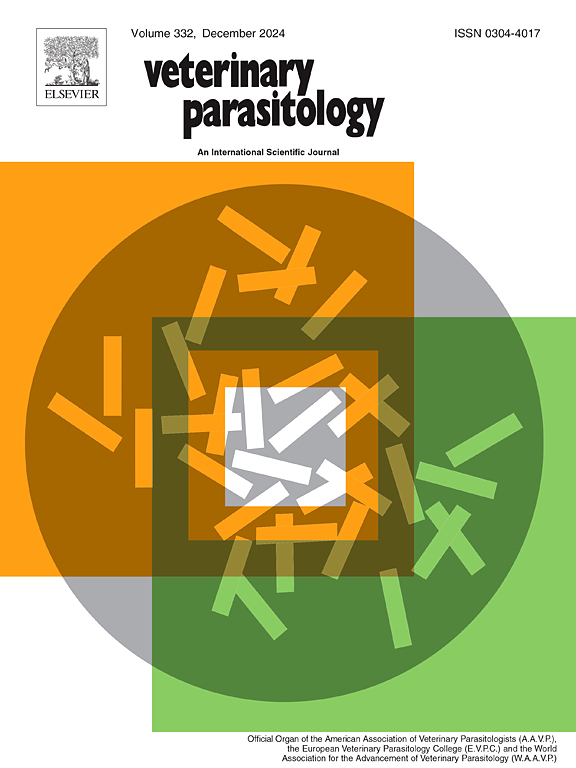Strategic control of gastrointestinal nematodes in equines in an extensive livestock production system in a tropical region
IF 2
2区 农林科学
Q2 PARASITOLOGY
引用次数: 0
Abstract
The strategic control of equine gastrointestinal nematodes is based on epidemiology. The aim is the reduction of the population of parasites as a whole in the hosts and environment while seeking the number of treatments that achieves the balance between not risking animal health and not exerting selection pressure for resistant parasites. This is the first study in a tropical region to assess a strategic control protocol for equines. The study was conducted in the municipality of Anastácio in the state of Mata Gross do Sul, Brazil, over a two-year period from April 2021 to March 2023, involving two groups of horses – control and treated. The animals in the treated group received oral ivermectin in the months of May and September in each year of the experiment. Every 28 days, feces were collected, the animals were weighed, the body condition score was calculated, eggs per gram (EPG) of feces were counted, and larval counts were performed in the pasture. Eggs were analyzed using real-time polymerase chain reaction for the identification of the species Strongylus vulgaris. Treatment reduced the EPG count (p < 0.05) and did not affect the weight or body condition score of the animals. The most prevalent taxon was Cyathostominae. Treatment was a protection factor against S. vulgaris (p < 0.05). A significant difference was found in the dry season between the control and treated groups in the analysis of larvae in the pasture. In conclusion, strategic control with two treatments during the year was capable of reducing the egg count, number of larvae in the pasture, and the presence of S. vulgaris without affecting health indicators, such as weight and body condition score.
热带地区粗放型畜牧生产系统中马胃肠道线虫的战略控制
马胃肠道线虫的战略控制是基于流行病学的。其目的是减少宿主和环境中寄生虫的整体数量,同时寻求在不危及动物健康和不对耐药寄生虫施加选择压力之间取得平衡的治疗方法的数量。这是在热带地区评估马的战略控制方案的第一次研究。该研究于2021年4月至2023年3月在巴西南马塔格罗斯州Anastácio市进行,为期两年,涉及两组马-对照组和治疗组。试验组于每年5月和9月口服伊维菌素。每28 d收集粪便,称重,计算体况评分,计数粪便中每克卵数,并在牧场进行幼虫计数。采用实时聚合酶链反应对普通圆线虫卵进行鉴定。治疗降低了EPG计数(p <; 0.05),不影响动物的体重或身体状况评分。最常见的分类群是Cyathostominae。治疗是对普通葡萄球菌的保护因子(p <; 0.05)。旱季牧草幼虫分析结果显示,对照组与处理组之间存在显著差异。综上所述,在一年中采用两种处理的策略控制能够减少牧草的卵数、幼虫数量和寻常夜蛾的存在,而不影响健康指标,如体重和身体状况评分。
本文章由计算机程序翻译,如有差异,请以英文原文为准。
求助全文
约1分钟内获得全文
求助全文
来源期刊

Veterinary parasitology
农林科学-寄生虫学
CiteScore
5.30
自引率
7.70%
发文量
126
审稿时长
36 days
期刊介绍:
The journal Veterinary Parasitology has an open access mirror journal,Veterinary Parasitology: X, sharing the same aims and scope, editorial team, submission system and rigorous peer review.
This journal is concerned with those aspects of helminthology, protozoology and entomology which are of interest to animal health investigators, veterinary practitioners and others with a special interest in parasitology. Papers of the highest quality dealing with all aspects of disease prevention, pathology, treatment, epidemiology, and control of parasites in all domesticated animals, fall within the scope of the journal. Papers of geographically limited (local) interest which are not of interest to an international audience will not be accepted. Authors who submit papers based on local data will need to indicate why their paper is relevant to a broader readership.
Parasitological studies on laboratory animals fall within the scope of the journal only if they provide a reasonably close model of a disease of domestic animals. Additionally the journal will consider papers relating to wildlife species where they may act as disease reservoirs to domestic animals, or as a zoonotic reservoir. Case studies considered to be unique or of specific interest to the journal, will also be considered on occasions at the Editors'' discretion. Papers dealing exclusively with the taxonomy of parasites do not fall within the scope of the journal.
 求助内容:
求助内容: 应助结果提醒方式:
应助结果提醒方式:


